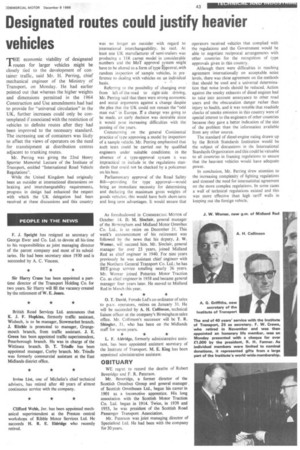Designated routes could justify heavier vehicles
Page 45

If you've noticed an error in this article please click here to report it so we can fix it.
THE economic viability of designated routes for larger vehicles might be closely tied to the development of container traffic, said Mr. H. Perring, chief mechanical engineer of the Ministry of Transport, on Monday. He had earlier pointed out that whereas the higher weights and dimensions permitted in the 1964 Construction and Use amendments had had to provide for "universal circulation" in the UK, further increases could only be contemplated if associated with the restriction of vehicles to definite routes after they had been improved to the necessary standard. The increasing use of containers was likely to affect the views of operators on the need for transhipment at distribution centres adjacent to trunking routes.
Mr. Perring was giving the 22nd Henry Spurrier Memorial Lecture of the Institute of Transport, entitled "International Road Vehicle Regulations".
While the United Kingdom had originally been an outsider at international discussions on braking and interchangeability requirements, progress in design had enhanced the respect with which the UK delegation had been received at these discussions and this country
was no longer an outsider with regard to international interchangeability, he said. At least one UK manufacturer of semi-trailers was producing a TIR carnet model in considerable numbers and the MoT approval system might have to be altered to a form of type tpproval, with random inspection of sample vehicles, in preference to dealing with vehicles on an individual basis.
Referring to the possibility of changing over from left ofthe road to right-side driving, Mr. Perring said that there were strong economic and social arguments against a change despite the plea that the UK could not remain the "odd man outin Europe. If a change was going to be made, an early decision was desirable since it would pose increasing difficulties with the passing of the years.
Commenting on the general Continental practice of type-approving a model by inspection of a sample vehicle, Mr. Perring emphasized that such tests could be carried out by qualified engineers under suitable conditions: in the absence of a type-approval system it was impractical to include in the regulations standards that could not be checked by a policeman on his beat.
Parliamentary approval of the Road Safety Bill—providing for type approval—would bring an immediate necessity for determining and declaring the maximum gross weights of goods vehicles; this would have both short-term and long term advantages. It would ensure that operators received vehicles that complied with the regulations and the Government would be able to negotiate reciprocal arrangements with other countries for the recognition of type approvals given in this country.
Although there were difficulties in reaching agreement internationally on acceptable noise levels, there was close agreement on the methods that should be used and a universal determination that noise levels should be reduced. Action against the smoky exhausts of diesel engines had to take into account annoyance to other road users and the obscuration danger rather than injury to health, and it was notable that roadside checks of smoke emission in this country were of special interest to the engineers of other countries because they gave a better indication of the size of the problem than the information available from any other source.
The standard of diesel-engine rating drawn up by the British Standards Institution would be the subject of discussions in tilt International Standards Organization and this could be valuable to all countries in framing regulations to ensure that the heaviest vehicles would have adequate power.
In conclusion, Mr. Perring drew attention to the increasing complexity of lighting regulations and stressed the need for internatiohal agreement on the more complex regulations. In some cases a wall of technical regulations existed and this was more effective than high tariff walls in keeping out the foreign vehicle.












































































































